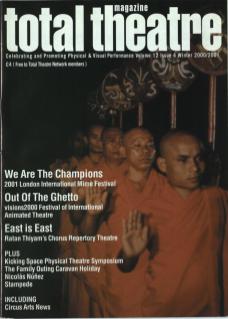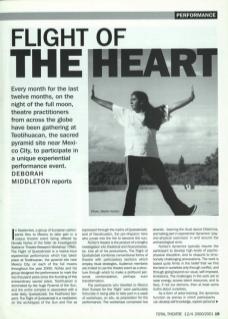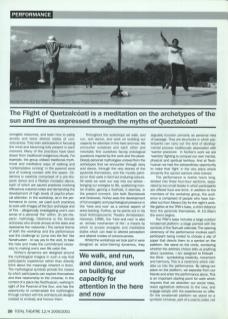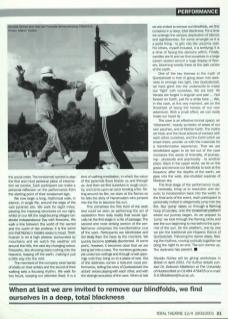In September, a group of European participants flew to Mexico to take part in a unique theatre event being offered by Nicolás Núñez of the Taller de Investigación Teatral or ‘Theatre Research Workshop’ (TRW). The Flight of Quetzalcoatl is a twelve-hour experiential performance which has taken place at Teotihuacan, the pyramid site near Mexico City, on each of the full moons throughout the year 2000. Núñez and his group designed the performance to mark the two thousand years since the founding of this extraordinary sacred place. Teotihuacan is dominated by the huge Pyramid of the Sun, and the entire complex is associated with a solar deity, Quetzalcóatl, the Feathered Serpent. The Flight of Quetzalcoatl is a meditation on the archetypes of the Sun and Fire as expressed through the myths of Quetzalcóatl, and of Nanahuatzin, the pre-Hispanic hero who jumps into the fire to become the sun.
Núñez's theatre is the product of a lengthy investigation into theatrical and ritual processes. Like all of his productions, The Flight of Quetzalcóatl combines conventional forms of theatre with participatory sections which employ ritual strategies. Audience members are invited to use the theatre event as a structure through which to make a profound personal contemplation, perhaps even transformation.
The participants who travelled to Mexico from Europe for the ‘flight' were particularly fortunate in being able to take part in a week of workshops, on site, as preparation for the performance. The workshops comprised two strands – learning the ritual dance Citlalmina, and taking part in experiential ‘dynamics' (psycho-physical exercises) in and around the archaeological zone.
Núñez's dynamics typically require the participant to develop high levels of psychophysical discipline, and to respond to emotionally challenging provocations. The work is based quite firmly in the belief that we find the best in ourselves only through conflict, and through going beyond our usual, self-imposed, limitations. The challenges in the work are to raise energy, access latent resources, and to face, if not our demons, then at least some truths about ourselves.
As a form of actor-training, the dynamics function as arenas in which participants can develop self-knowledge, explore personal energetic resources, and learn how to safely access and leave altered states of consciousness. They train participants in focusing the mind and becoming fully present in each moment. Many of the practices have been drawn from traditional indigenous rituals. For example, the group utilised traditional rhythmical and meditative ways of walking and 'contemplative running’ in the pyramid zone and of making contact with the space. Citlalmina is carefully comprised of a pre-Hispanic dance and a Tibetan monastic dance, each of which are sacred practices involving efficacious corporeal codes and demanding the development of high levels of psycho-physical attention. In the workshop, as in the performance to come, we used such practices to work with images of the Sun archetype and of Fire – allegorically investigating one's own sense of a personal ‘fire' within. (In pre-Hispanic mythology, Citlalmina is the female archeress who shoots arrows at the stars and represents the meteorite.) The central theme of both the workshop and the performance was the challenge to ‘jump into the fire’ like Nanahuatzin – to say yes to the void, to take the risks and make the commitment necessary to making one's own life catch fire.
Núñez's dynamics are designed around the mythological imagery in such a way that participants experience rather than directly think about the meanings inherent in them. The mythological symbols provide the means by which participants can explore themselves and their relationship to the Universe. In the context of a place like Teotihuacan, working in sight of the Pyramid of the Sun, one has the opportunity to contemplate the mythologies through contact with the architectural designs created to embody and honour them.
Throughout the workshops we walk, and run, and dance, and work on building our capacity for attention in the here and now. We encounter ourselves and each other and inevitably find ourselves facing ontological questions inspired by the work and the place. Deeply personal mythologies unravel from the archetypes that we encounter through story and dance, through the very stones of the pyramids themselves, and the murals painted on their walls in faint but enduring colours. All week we work our way into our selves – bringing our energies to life, quietening mental chatter, gaining a foothold, it seemed, in the present moment. Like both Stanislavski and Grotowski, Núñez sees the development of full energetic and psychological presence in the ‘here and now’ as a central aspect of actor-training. Further, as he points out in his book Anthropocosmic Theatre (Amsterdam: Harwood, 1996), the ‘here and now' is also an 'archaic mechanism of rite': a means by which to access energetic and meditative states which can lead to altered perception and altered modes of consciousness.
The Flight of Quetzalcóatl is a meditation on the archetypes of the sun and fire as expressed through the myths of Queztalcóatl
Whilst the workshops we took part in were designed as actor-training dynamics, they arguably function primarily as personal rites of passage. They are structures in which participants can carry out the kind of developmental process traditionally associated with 'Warrior practices'. In Núñez's work we are 'Warriors' fighting to conquer our own mental, physical and spiritual territory. And at Teotihuacan we had the extraordinary opportunity to make that fight in the very place where anciently the sacred warriors were trained.
The performance is twelve hours long, divided into three four-hour sections, separated by two small breaks in which participants are offered food and drink. In addition to the members of the workshop group, the audience is comprised of people who have travelled out from Mexico City for the night's work. We gather at the TRW's base, a short distance from the pyramids themselves. At 10.30pm the event begins.
The TRW's base includes a large outdoor tonalamatl platform: a stage painted with the symbols of the Nahuatl calendar. The opening ceremony of the performance involves each participant being invited to choose a slip of paper that directs them to a symbol on the platform. We stand on the circle, wondering whether the arbitrary choice tells us anything about ourselves. I am assigned to Ehecati – the Wind – symbolising creativity, movement and harmony. This is a ceremony which initiates us into the performance. By taking our place on the platform, we separate from our friends and enter the performance alone. This is an important starting point for work which requires that we abandon our social roles, resist egotistical defences to the new, and engage deeply with the experiences on offer. On the tonalamatl platform we stand on a symbolic Universe, part of a cosmic order, not the social order. The tonalamatl symbol is also the first and most personal piece of information we receive. Each participant can make a personal reflection on the performance from the starting point of their tonalamatl sign.
We now begin a long, rhythmical walk, in silence, in single file, around the edge of the vast pyramid site. We walk for eight miles, passing the imposing structures on our right, whilst on our left the neighbouring villages celebrate Independence Day with fireworks. We walk a line between the world of the sacred and the world of the profane; it is the same line that Núñez's theatre seeks to tread. Teotihuacan is on a high plateau surrounded by mountains and we watch the weather roll around the hills, the vast sky changing colour. Fireworks, like shooting stars rushing into the heavens, leaping off the earth, making it just a little way into the void.
The members of the company wear bands of shells on their ankles and the sound of their walking sets a focusing rhythm. We walk for two hours, keeping our attention fixed. It is a kind of walking meditation, in which the vision of the pyramids flows beside us and through us. And then we find ourselves in rough country, and come upon an actor tending a fire. Sitting around his fire, we stare at the flames as he tells the story of Nanahuatzin who jumped into the fire to become the sun.
This comprises the first third of the work and could be seen as performing the act of separation from daily reality that would typically be the first stage in a rite of passage. The second and most striking section of the performance comprises the transformative crux of the work. Participants are blindfolded and led away from the base by the monitors. We quickly become spatially disoriented. At some point, however, it becomes clear that we are being led into a cave. The monitors guide people under low ceilings and through small openings until they bring us to a place of rest. Out of the darkness comes a textured vocal performance, telling the story of Quetzalcóatl; the actors' voices playing with each other, and with the strange acoustics of the cave. When at last we are invited to remove our blindfolds, we find ourselves in a deep, total blackness. For a time we undergo the sensory deprivation of silence and sightlessness. For some amongst us it is a joyful thing – to grin into the uncanny void. For others, myself included, it is terrifying – it is a time of facing the demons within. Finally, candles are lit and we find ourselves in a large cavern seated around a huge display of flowers, blooming weirdly there at the dark centre of the earth.
When at last we are invited to remove our blindfolds, we find ourselves in a deep, total blackness
One of the key themes in the myth of Quetzalcoatl is that of going down into darkness to emerge into light. Like Quetzalcóatl, we have gone into the underworld to make our 'light' with ourselves. We are told: ‘All heroes are forged in anguish and pain ... Not forever on Earth, just for a while here... We, in this cave, at this very moment, are on the threshold of being the heroes of our own adventure. With a small effort, we can really make our heart fly.’
The cave is an effective liminal space; an ‘otherworld', heavily symbolic of areas of our own psyches, and of Mother Earth. The myths we hear, and the ritual actions of contact with each other, ourselves, and the Earth which we enact there, provide us with the materials for a transformative experience. That we are blindfolded again to be led out of the cave increases this sense of liminality, of journeying – physically and psychically – to another place. Back in the upper world, we lie on the grass and remove our blindfolds to look at the heavens; after the depths of the earth, we gaze into the wide, star-studded expanse of Mexican sky.
The final stage of the performance must, by necessity, bring us to resolution and closure; to incorporation back into the world. In the final acts of the event, each participant is personally invited to allegorically jump into the fire. Our ‘jump' takes us through a flaming hoop of candles, onto the tonalamatl platform where our journey began. As we prepare to ‘jump' we look through the flaming circle and see the sun beginning to rise behind the pyramid of the sun. On the platform, one by one we join the traditional pre-Hispanic Dance of Quetzalcóatl. Following the dance steps, feeling the rhythms, moving cyclically together we bring the night to an end. The sun comes up. The darkness has passed.
Nicolás Núñez will be giving workshops in Britain in April 2001.



